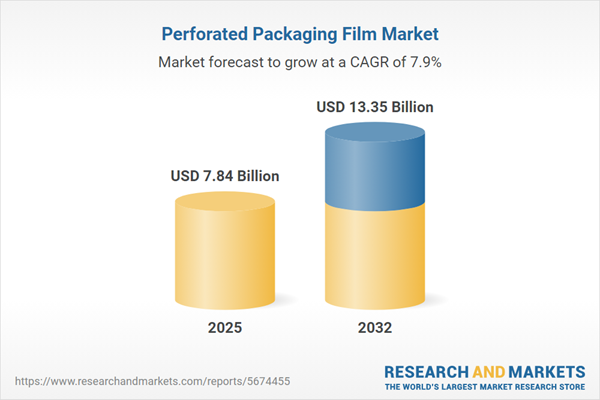Speak directly to the analyst to clarify any post sales queries you may have.
Senior decision-makers in the perforated packaging film market must navigate a landscape shaped by changing regulatory demands, sustainability imperatives, and rapid technological advancement. Achieving success in this evolving environment hinges on responsive business strategies and a clear understanding of global supply chain interdependencies.
Market Snapshot: Perforated Packaging Film Market Growth and Opportunity
The global perforated packaging film market is valued at USD 7.28 billion in 2024 and expected to reach USD 7.84 billion in 2025, demonstrating a CAGR of 7.87%. This momentum reflects heightened sustainability standards, targeted waste-reduction goals, and an increasing emphasis on food safety. Food industry segments such as bakery, produce, dairy, and processed foods increasingly adopt technical packaging to secure longer product shelf life and reduce spoilage. For senior leaders, recognizing these shifts is key to modeling risk and maximizing returns as compliance and operational standards evolve.
Scope & Segmentation of the Perforated Packaging Film Market
This report offers actionable market segmentation to align strategies with sector transformation and enable informed decision-making:
- End Use: Bakery and confectionery, dairy products, fresh fruits and vegetables, meat and poultry, fish and seafood, and processed foods. Each category has specific perforation and preservation requirements for maintaining product freshness and quality.
- Material: Polyethylene grades (high-density, linear low-density, low-density), various types of polypropylene, and polyvinyl chloride are predominant for their durability, regulatory fit, and environmental adaptability.
- Film Type: Blown, cast, multilayer, single-layer, and co-extruded films address unique packaging goals for barrier strength, shelf life extension, and distribution logistics.
- Technology: Laser, macro-, and microperforation, and water jet methods are used to optimize air and moisture control, enhancing freshness and productivity compared to mechanical perforation techniques.
- Thickness: Lightweight through heavy-duty options support regulatory needs, logistics, and robust protection across diverse applications.
- Geographical Coverage: The market spans the Americas, EMEA, and Asia-Pacific. These regions reflect varied regulation, consumer tendencies, and technology adoption, shaping different strategic approaches.
- Leading Industry Players: Amcor plc, Berry Global Group, Sealed Air Corporation, Mondi plc, Sonoco Products Company, ProAmpac, Klöckner Pentaplast Group, Huhtamaki Oyj, Winpak Ltd., and Tekni-Plex demonstrate both sector depth and international reach.
Key Takeaways for Perforated Packaging Film Decision-Makers
- Embracing new perforation technologies such as laser-based systems enables tailored solutions, which support companies’ sustainability and brand distinction goals.
- Anticipating regulatory changes concerning plastics encourages early adoption of recyclable and bio-based film formats. This positions organizations to meet compliance and emerging consumer expectations.
- Strategic imperatives differ by geography: the Americas concentrate on streamlining logistics, EMEA organizations prioritize low-impact manufacturing, and Asia-Pacific players focus on technology-driven supply chain integration.
- Fostering collaboration between converters, technology providers, and brand owners drives nimble innovation cycles, allowing companies to respond rapidly to regulatory and market shifts.
- Integrating digital printing and smart packaging strengthens traceability and improves cold chain reliability, supporting the requirements of dynamic, omnichannel food distribution.
- Adaptive inventory and production planning fortifies supply chain resilience, reducing vulnerability to volatility caused by shifting tariffs and regulation.
Tariff Impact: Managing Supply Chain Volatility
Recent U.S. tariff policy adjustments have prompted manufacturers to diversify supplier bases, renegotiate contracts, and build ties with local partners. These measures provide added flexibility in material sourcing and help mitigate unpredictable tariff-related risks, supporting continuity in both manufacturing and brand supply chains.
Methodology & Data Sources
This analysis draws from secondary research, comprehensive literature review, and direct engagement with leading supply chain stakeholders. Triangulated data sources underpin accurate reporting and a foundational understanding for executive decisions in the perforated packaging film market.
Why This Report Matters for Senior Decision-Makers
- Equips leaders with intelligence to anticipate how new technologies and compliance dynamics shape competitive advantage and operational performance.
- Delivers practical insights on how regional and segment-specific developments influence supply chain integrity, risk response, and performance optimization.
- Allows benchmarking for ESG enhancement and proactive compliance management in shifting packaging industry contexts.
Conclusion
The perforated packaging film market is evolving through material innovation, regulatory focus, and technological change. This report enables senior decision-makers to formulate robust strategies and build resilient, future-ready supply chains.
Additional Product Information:
- Purchase of this report includes 1 year online access with quarterly updates.
- This report can be updated on request. Please contact our Customer Experience team using the Ask a Question widget on our website.
Table of Contents
3. Executive Summary
4. Market Overview
7. Cumulative Impact of Artificial Intelligence 2025
List of Figures
Samples

LOADING...
Companies Mentioned
The key companies profiled in this Perforated Packaging Film market report include:- Amcor plc
- Berry Global Group, Inc.
- Sealed Air Corporation
- Mondi plc
- Sonoco Products Company
- ProAmpac, LLC
- Klöckner Pentaplast Group GmbH
- Huhtamaki Oyj
- Winpak Ltd.
- Tekni-Plex, Inc.
Table Information
| Report Attribute | Details |
|---|---|
| No. of Pages | 196 |
| Published | October 2025 |
| Forecast Period | 2025 - 2032 |
| Estimated Market Value ( USD | $ 7.84 Billion |
| Forecasted Market Value ( USD | $ 13.35 Billion |
| Compound Annual Growth Rate | 7.8% |
| Regions Covered | Global |
| No. of Companies Mentioned | 11 |









